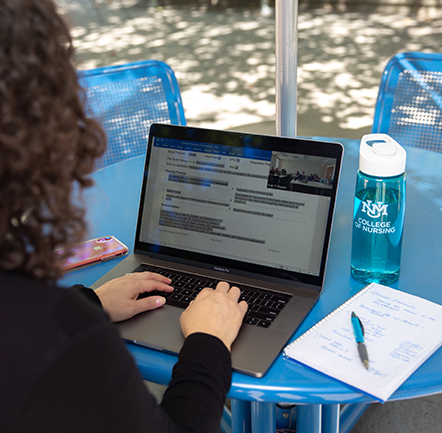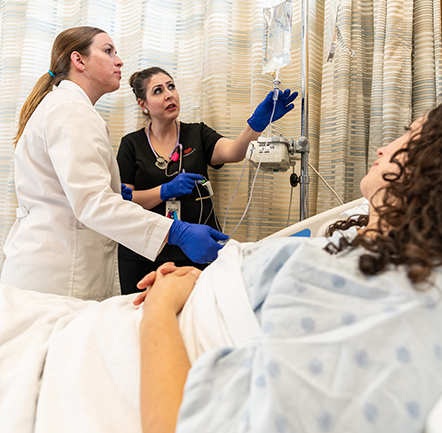We encourage preceptors to review the guidelines, as well as the checklists that correspond to their clinical rotations, in order to ensure successful learning experiences. This information offers a greater understanding of roles and expectations. Specific information about the clinical course for which you are precepting will be sent via email at least six weeks prior to the start of the rotation. This includes course and clinical objectives as well as a syllabus.
New and returning preceptors, please review the guidelines for clinical rotations below.
For most clinical courses, preceptors and students are expected to complete at least one or more evaluations. More detailed instructions about the evaluation process will be sent directly to preceptors.
Clinical attendance is mandatory, and students are expected to demonstrate professionalism. If for any reason a student is unable to participate in a clinical session or will be arriving late, the student must notify the preceptor as far in advance as possible in addition to the Program Coordinator, the faculty site visitor or faculty liaison. Preceptors are encouraged to contact the Program Coordinator, course instructor, faculty site visitor or faculty liaison at any time during the rotation to address concerns about student performance or consult about teaching methods.
Many clinical courses require at least one site visit by a faculty member during the rotation to observe the student’s performance and to discuss pertinent learning issues with the preceptor. The visit will include observation of the student with clients, review of the case logs and self-evaluation tools and consultation with the preceptor. The appointment will be scheduled with the student who will notify the preceptor once a date has been confirmed. A typical site visit will last approximately four hours. Every effort is made to ensure the visit does not disrupt practice operations.
The College of Nursing utilizes a specialized database management system to track patients seen by the student and allow faculty and preceptors to monitor the student’s progress during the term. Preceptors will be assigned a secure user account as well as provided log in instructions prior to the start of the rotation.
The data collected on patient encounters includes age, sex, race, insurance, diagnosis, time spent with the patient, and medications. Students do not enter patient names, ID numbers or other identifying data that would violate the privacy of the patient. In addition, students enter ICD-10 and procedure codes, which offer them real experience with billing and coding.
The Typhon Time Log tool is used by students to track their clinical rotation shift hours. Preceptors are able to view their students’ Time Log entries to determine the number of hours students have worked with them. Preceptors also can access detailed reports of the student’s patient encounters if the student entered them as the preceptor. There are two types of reports available: Case Log Details and Case Log Highlights.
EASI (Evaluation And Survey Instrument) is Typhon Group’s online module for completing evaluations. Most of the graduate programs utilize EASI for preceptor student evaluations. An email will be sent to preceptors that provides a link to the evaluation form along with instructions.
For more information about the system or to request a demonstration, please contact UNM-CON-Clinical-Affairs@salud.unm.edu.
EMR privileges for students are determined by the clinical sites. The College of Nursing does not endorse students using their preceptors’ log-ins. Students are required to use the course’s template to document at least two patient visits per day (leaving out identifying data), which the site visitor or faculty liaison reviews to assess their charting skills. The preceptor is encouraged to look over the notes with the student as well. If students do not have access to EMR, then they should use the form provided by the course for all documentation.
The CON encourages their clinical instructors to become familiar with FERPA’s provisions and their responsibility to protect the confidentiality of student education records. The UNM Office of the Registrar offers an online manual that covers all aspects of federal law.
In accordance with FERPA policy, preceptors should use a secure email when sending evaluations and other correspondence about student performance. Communication also can be sent to the CON’s secure fax address at (505) 272-5280. Please be sure to attach a cover page when faxing.
Students are encouraged to present preceptors with a copy of their CV at the beginning of the rotation. Preceptors can also view an electronic version of the CV in Typhon. For instructions, please refer to the CV viewing handout.
Prior to the start of the clinical experience, the College of Nursing will prepare an affiliation agreement with the facility. Students are expected to meet both the College of Nursing’s as well as the site’s compliance requirements. If requirements are not stated, students are directed to check with their preceptors.
Clinics who would like to notify their patients that a learner is on-site for a clinical rotation can print out this flyer to post or distribute in the clinic.
Preceptors are eligible for a Volunteer Adjunct Faculty appointment in recognition of their service. An explanation of the benefits associated with the appointment can be found on the Benefits Request form. The form is also uploaded in Typhon School Documents. Preceptors who would like to participate or renew their benefits should submit a completed form and their CV to UNM-CON-Clinical-Affairs@salud.unm.edu.
In addition, the College of Nursing periodically holds in-person as well as virtual professional development workshops for preceptors that cover a variety of themes, including preceptor skills, cultural perspectives, and clinical topics. Free CME’s are available for those who participate.
The College of Nursing’s accrediting agencies require specific data about its preceptors and clinical sites in order to ensure clinical placements are providing appropriate learning experiences for the students. Preceptors can help the CON fulfill its obligations by completing and submitting this Data Form.
Your role as a preceptor is vital to the success of the student’s academic career and ultimately of the student’s own professional practice. We encourage you to reflect on the following responsibilities and expectations throughout the rotation to ensure you are helping the student fulfill all requirements.
Download your checklist.
We provide free professional development workshops, trainings and conferences for continuing education credits. For more details visit our EVENTS webpage.
With telehealth video and phone visits becoming the norm these days, we wanted to provide you with some tips for teaching students. We hope you find this information helpful!
Join Carolyn Montoya, PhD, RN, CNPNP, FAAN, FAANP, Interim Vice Dean and Professor at The University of New Mexico College of Nursing discussing preventing burnout for clinicians/preceptors.
Many faculty at the CON precept students in their own practices. Here are shared best practices and tips for creating an optimal learning environment. We welcome your pearls from your own personal precepting experiences. Please send them to UNM-CON-Clinical-Affairs@salud.unm.edu
"Ask the student their goals for the day. What specific patient types would help them meet their goals? What specific area(s) are they working on right now? Then at the end of the day review which goals they were able to achieve, how they met their goals, and which goals remain. The goals that remain are a good place to start for the next clinical day. That way both the student and preceptor have a clear understanding of what the student would like to accomplish on a day-to-day basis. This also puts the responsibility for their learning on the student, helps them to identify their strengths and areas for improvement, and provides a "list" of goals that gets updated daily."
Tamara Hall, DNP, RN, CPNP-BC, Nursing Education Program Coordinator, Pediatric Nurse Practitioner Program Coordinator and Assistant Professor
Time management is one of the greatest challenges for me when precepting. In order to avoid running behind, I assign the student to every other or every third patient. I also have the student stop seeing patients around 3:30 p.m. or 4:00 p.m. so he/she can finish paperwork and we can leave on time.
Kristen Ostrem-Niemcewicz, DNP, RN, CNM, FNP-BC, Interim Associate Dean of Academic Affairs and Associate Professor.

Unique in a primary care setting – The College of Nursing runs the Primary Care TeleECHO Clinic.
Bringing together a broad interprofessional team committed to reaching beyond our campus, beyond our borders, to address the needs of all New Mexicans.
Typhon is a tool that allows you to monitor your student's progress.
Learning a new system – even one that is designed to help you – can be intimidating. We prepared for that. Check out our Typhon Support web page for all the information you need to get started and learn to use Typhon. You will be an expert in no time!
As a MSN or DNP preceptor we offer you a variety of benefits. Please download the form below to select your benefits.
Submit completed form along with your Data Form and current CV to Clinical Affairs UNM-CON-Clinical-Affairs@salud.unm.edu

Volunteer your time, share your knowledge and partner with our faculty to educate the next generation of nurses.
College of Nursing
Clinical Affairs
Building 214
Suite 3401
1 University of New Mexico
Undergraduate Programs: CON-UG-ClinicalPlacements@salud.unm.edu
Graduate Programs: CON-Grad-ClinicalPlacements@salud.unm.edu